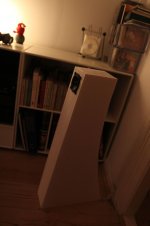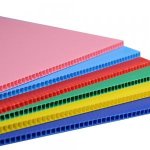YouTube
This guy's videos up in the link there and his "foam core basics".
I saw his videos and went from a cheap dollar store breakaway knife to digging out my old Xacto with a #2 blade (probably could just have gone with a stronger and wider OLFA, but I had the Xacto already). Makes a big difference and knowing how deep to and how to cut versus tearing away with a dull edge. Always sharp makes it easier.
Great info, thanks.I wonder if we can build portable speaker boxes this way.
Foam core.. wd it work for larger speaker cabs?
You can make it big. Here is a Nautiloss subwoofer with quad 6.5in drivers in isobaric mode.
Entire 20x30 sheet per side panel. Lots of bracing.
I think this might be a good foam core project.
Duetta Top-Design - Ausgabe September 2013 - Lautsprecherbau-Magazin 2013 | Lautsprecherbau - Lautsprecher selber bauen
Duetta Top-Design - Ausgabe September 2013 - Lautsprecherbau-Magazin 2013 | Lautsprecherbau - Lautsprecher selber bauen
I think this might be a good foam core project.
Duetta Top-Design - Ausgabe September 2013 - Lautsprecherbau-Magazin 2013 | Lautsprecherbau - Lautsprecher selber bauen
Wow. That guy is practically master luthier in skill.
That build would look pretty slick in black foamcore with maybe 4FE25 drivers
I've been kicking around ideas for making internal panels and bracing, that are formed of honeycombs or lattices. That is: strong-but-open structures. The openness of the structure would allow you to use lots and lots of bracing, without the bracing using up all the speaker's internal volume.
So... for larger foamcore cabs, maybe you could use corflute as bracing?
1) start with two big sheets of 5mm thick corflute
2) slice them into 50mm strips
3) laminate 10 strips together to get 50x50mm 'beams'.
Because each 'beam' would be mostly made of air, you build a dense matrix of braces with them, without greatly reducing the internal volume of the box.
If your cuts (step 2) were in different orientations, the corflute 'ribs' would be at 90 degrees to each other (cross laminated), for extra stability.
So... for larger foamcore cabs, maybe you could use corflute as bracing?
1) start with two big sheets of 5mm thick corflute
2) slice them into 50mm strips
3) laminate 10 strips together to get 50x50mm 'beams'.
Because each 'beam' would be mostly made of air, you build a dense matrix of braces with them, without greatly reducing the internal volume of the box.
If your cuts (step 2) were in different orientations, the corflute 'ribs' would be at 90 degrees to each other (cross laminated), for extra stability.
Attachments
I've been kicking around ideas for making internal panels and bracing, that are formed of honeycombs or lattices. That is: strong-but-open structures. The openness of the structure would allow you to use lots and lots of bracing, without the bracing using up all the speaker's internal volume.
So... for larger foamcore cabs, maybe you could use corflute as bracing?
1) start with two big sheets of 5mm thick corflute
2) slice them into 50mm strips
3) laminate 10 strips together to get 50x50mm 'beams'.
Because each 'beam' would be mostly made of air, you build a dense matrix of braces with them, without greatly reducing the internal volume of the box.
If your cuts (step 2) were in different orientations, the corflute 'ribs' would be at 90 degrees to each other (cross laminated), for extra stability.
There's a foam core alternative, about the same thickness but made of plastic with a similar internal cell structure. I had some lying around so I built a cabinet out of it. It was not nearly as good as foam core.
For internal bracing it should work fine. But if I read your post right and you are thinking the openings would take up less space and let sound pass, that may be but in the case of my material, it needs to be oriented cross-wise for strength. So you'd need to "cross-laminate" as you suggest but then half of the opening is removed (at least with my material), substantially reducing the effectiveness.
I'd be interested to hear back if anyone uses that material.
Last edited:
I've been kicking around ideas for making internal panels and bracing, that are formed of honeycombs or lattices. That is: strong-but-open structures. The openness of the structure would allow you to use lots and lots of bracing, without the bracing using up all the speaker's internal volume.
So... for larger foamcore cabs, maybe you could use corflute as bracing?
1) start with two big sheets of 5mm thick corflute
2) slice them into 50mm strips
3) laminate 10 strips together to get 50x50mm 'beams'.
Because each 'beam' would be mostly made of air, you build a dense matrix of braces with them, without greatly reducing the internal volume of the box.
If your cuts (step 2) were in different orientations, the corflute 'ribs' would be at 90 degrees to each other (cross laminated), for extra stability.
Because the air volume is inside a narrow channel with large length/dia ratio, the air columns have a lot of viscous drag and this may be beneficial and act in a similar way to stuffing or polyfill, although probably not as good for same volume of polyfill.
Stiff open cell reticulated foam could be cut into blocks (and be porous) and provide internal structural support like a surfboard and make quite a lighweight yet stiff cabinet with very good damping.
If I understand, your lattice approach sounds like B&W's Matrix.I've been kicking around ideas for making internal panels and bracing, that are formed of honeycombs or lattices. That is: strong-but-open structures. The openness of the structure would allow you to use lots and lots of bracing, without the bracing using up all the speaker's internal volume.
Do you have any pictures of it finished? Are they still alive? Great job there, I have a pair of FH3 and it really shines.Thanks for the feedback, the second one is done now and i've listened a bit to them in a largeish living room. <snip>
Here is a photo:

They are currently living at my parents house, but i spent some time with them recently, listening from a cheap class D amp (sure TDA3116-based) and they sounded great in the small room they now live in. They get a bit shouty when played very loud, but thats ok, i usually don't need excessive volume for my average listening.

They are currently living at my parents house, but i spent some time with them recently, listening from a cheap class D amp (sure TDA3116-based) and they sounded great in the small room they now live in. They get a bit shouty when played very loud, but thats ok, i usually don't need excessive volume for my average listening.
So you'd need to "cross-laminate" as you suggest but then half of the opening is removed (at least with my material), substantially reducing the effectiveness.
With corflute, you could be a bit wasteful with material, and cut the 'beams' so that the ribs are at 45 degrees to the length of the 'beam'. You'd get the strength of perpendicular ribs, and no openings (volume) would be lost.
Because the air volume is inside a narrow channel with large length/dia ratio, the air columns have a lot of viscous drag and this may be beneficial and act in a similar way to stuffing or polyfill, although probably not as good for same volume of polyfill.
Yes. Follow the link in post 1, and see the sound absorption tab. It looks like they are better than stuffing, but over a narrower range.
Alu honeycomb panel
The 40mm panel seems to absorb best around 400Hz, and presumably this absorption peak scales with thickness, so a 20mm panel would be best at 800Hz.
A DIY effort could perhaps use 'beams' that are more than 40mm thick, to try to get decent absorption < 400Hz, where polyfill is pretty ineffective.
Stiff open cell reticulated foam could be cut into blocks (and be porous) and provide internal structural support like a surfboard and make quite a lighweight yet stiff cabinet with very good damping.
Is there an open cell foam that's really stiff enough to provide bracing? In the link above, that's the sort of suggestion I was hoping for.
The black gravel grid stuff I picked up is pretty good. At 3.8kg / m^2 it comes in a lot heavier than foam or foamcore, but is 1/10 the weight of plywood (of the same thickness).
They are currently living at my parents house, but i spent some time with them recently, listening from a cheap class D amp (sure TDA3116-based) and they sounded great in the small room they now live in. They get a bit shouty when played very loud, but thats ok, i usually don't need excessive volume for my average listening.
Silasmellor,
Is that a full size FH3 in XPS foam or a scaled down one with a 3FE23?
- Home
- Loudspeakers
- Full Range
- Foam Core Board Speaker Enclosures?


